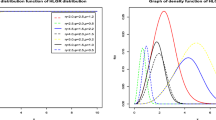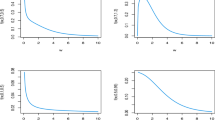Abstract
A framework of two-sided densities is presented for asymmetric continuous distributions consisting of two branches each with its own generating density. The framework supports the construction of distributions with positive support and a specified mode. Examples thereof shall be constructed using the beta and Burr Type XII distributions for their left and right branch densities. The examples are parameterized via left and right branch scale parameters, a mode parameter and two parameters determining the heaviness of its right tail. Keeping one of the tail parameters fixed, a procedure solving for their parameters is presented given a lower and upper quantile, a mode and a conditional-value-at-risk, popular in risk management of insurance losses. While valuable on its own right, that solution may be used as a starting point for a maximum likelihood routine. The estimation of the parameters is demonstrated using the classical insurance Danish fire loss data set and a French business loss interruption data set. Both data sets are publicly available. Developed models compare favorably with prior models fitted to the Danish fire loss data in the literature.







Similar content being viewed by others
Data availability statement
The Danish fire insurance loss data set is publicly available in the “SMPracticals” package (Davison 2019) for R (R Core 2021) under the acronym “danish”. The French business interruption loss data set is publicly available in the “CASdatasets” package (Dutang and Charpentier 2020) for R (R Core Team 2021) under the acronym “frebiloss”.
Notes
See, Table 2 on page 151 in Bakar et al. (2015)
References
Akaike H (1974) A new look at the statistical model identification. IEEE Trans Autom Control 196:716–723
Bakar SA, Hamzah NA, Maghsoudi M, Nadarajah S (2015) Modeling loss data using composite models. Insur Math Econ 61:146–154
Bakar SA, Nadarajah S (2021) Composite models with underlying folded distributions. J Comput Appl Math 390:113351
Bhati D, Calderín-Ojeda E, Meenakshi M (2019) A new heavy tailed class of distributions which includes the pareto. Risks 74:99
Bhati D, Ravi S (2018) On generalized log-moyal distribution: a new heavy tailed size distribution. Insur Math Econ 79:247–259
Bickel DR, Frühwirth R (2006) On a fast, robust estimator of the mode: comparisons to other robust estimators with applications. Comput Stat Data Anal 5012:3500–3530
Burr IW (1942) Cumulative frequency functions. Ann Math Stat 132:215–232
Byrd RH, Lu P, Nocedal J, Zhu C (1995) A limited memory algorithm for bound constrained optimization. SIAM J Sci Comput 165:1190–1208
Calderín-Ojeda E, Kwok CF (2016) Modeling claims data with composite Stoppa models. Scand Actuar J 20169:817–836
Cooray K, Ananda MM (2005) Modeling actuarial data with a composite lognormal-pareto model. Scand Actuar J 20055:321–334
Davison A (2019) Smpracticals [Computer software manual]. https://CRAN.R-project.org/package=SMPracticals R package version 1.4.3
Dominicy Y, Sinner C (2017) Distributions and composite models for size-type data. Adv Stat Methodol Their Appl Real Probl 159
Dutang C, Charpentier A (2020) Casdatasets [Computer software manual]. http://dutangc.perso.math.cnrs.fr/RRepository R package version 1-0-12
Eling M (2012) Fitting insurance claims to skewed distributions: Are the skew-normal and skew-student good models? Insur Math Econ 512:239–248
Fisk PR (1961) The graduation of income distributions. Econom J Econom Soc 29:171–185
Gómez-Déniz E, Calderín-Ojeda E (2020) Financial and actuarial properties of the beta-pareto as a long-tail distribution. Span J Stat 2:7–21
Herrerias-Velasco JM, Herrerias-Pleguezuelo R, van Dorp JR (2009) The generalized two-sided power distribution. J Appl Stat 365:573–587
Hyndman RJ, Fan Y (1996) Sample quantiles in statistical packages. Am Stat 504:361–365
Jordanova P, Stehlík M (2020) Ipo estimation of heaviness of the distribution beyond regularly varying tails. Stoch Anal Appl 381:76–96
Käärik M, Kadarik H (2013) Statistical inference with the limited expected value function. Multivariate statistics: theory and applications. World Scientific, Singapore, pp 99–111
Klugman S, Panjer H, Willmot G (1998) Loss models. Wiley, New York, NY, USA
Konishi S, Kitagawa G (2008) Information criteria and statistical modeling. Springer, New York
Kotz S, Kozubowski T, Podgorski K (2012) The laplace distribution and generalizations: a revisit with applications to communications, economics, engineering, and finance. Springer, New York
Kotz S, van Dorp JR (2004) Beyond beta: other continuous families of distributions with bounded support and applications. World Scientific, Singapore
Lomax KS (1954) Business failures: another example of the analysis of failure data. J Am Stat Assoc 49268:847–852
McNeil AJ (1997) Estimating the tails of loss severity distributions using extreme value theory. ASTIN Bull J IAA 271:117–137
Mead M (2015) Generalized inverse gamma distribution and its application in reliability. Commun Stat-Theory Methods 447:1426–1435
Nadarajah S, Bakar SA (2014) New composite models for the Danish fire insurance data. Scand Actuar J 20142:180–187
Poncet P (2019) modeest [Computer software manual]. https://cran.r-project.org/web/packages/modeest/index.html R package version 2.4.0
R Core Team (2021) R: a language and environment for statistical computing [Computer software manual]. Vienna, Austria. https://www.R-project.org/
Resnick SI (1997) Discussion of the Danish data on large fire insurance losses. ASTIN Bull J IAA 271:139–151
Rubio FJ, Steel MF (2020) The family of two-piece distributions. The family of two-piece distributions. Wiley, New Jersey
Scollnik DP (2007) On composite lognormal-pareto models. Scand Actuar J 20071:20–33
Scollnik DP, Sun C (2012) Modeling with weibull-pareto models. N Am Actuar J 162:260–272
Teodorescu S, Vernic R (2009) Some composite exponential-pareto models for actuarial prediction. Romanian J Econ Forecast 124:82–100
van Dorp JR, Shittu E (2023) The generalized two-sided beta distribution with applications in project risk analysis. J Stat Theory Pract 173:38
Wallis KF (2014) The two-piece normal, binormal, or double gaussian distribution: its origin and rediscoveries. Stat Sci 29:106–112
Wong TS, Li WK (2021) A new test for tail index with application to Danish fire loss data. J Stat Comput Simul 9118:3880–3893
Acknowledgements
We are grateful to the reviewers and the co-editor whose comments significantly improved the prior version of this article.
Funding
The authors have not received any funding for the research in this manuscript.
Author information
Authors and Affiliations
Corresponding author
Ethics declarations
Conflict of interest
On behalf of all authors, the corresponding author states that there is no conflict of interest.
Additional information
Publisher's Note
Springer Nature remains neutral with regard to jurisdictional claims in published maps and institutional affiliations.
Appendices
Appendix A: The Burr Type XII distribution
Let \(X\sim Burr(n,\tau ,\nu )\) (Burr 1942) with pdf
From (A1) one obtains the cdf
and from (A2) the quantile function
After som algebraic manipulations, one derives with (A1) that
Finally, from (A1) one obtains
where \(x_p\) is given by (A3). Thus \(CVaR_p[X]\) (A5) is finite for \(\nu >1/\tau\) and infinite otherwise.
Appendix B: The generalized log-Moyal distribution
Let \(X\sim GlogM(\theta ,\nu )\), i.e. generalized log-Moyal distributed (Bhati and Ravi 2018), with pdf
One obtains from (B6) the cdf
where \(\Phi (\cdot )\) is the standard normal cdf. From (B7) one derives the quantile function
After some algebraic manipulations, one obtains with (B6) for the raw moments
which are finite for \(\nu >k\) and infinite otherwise. Finally, from (B6) one derives
where \(V\sim Gamma(\alpha ,\beta )\), \(\alpha =\frac{1}{2}(1-\frac{1}{\nu })\), \(\beta =1\) with pdf
Thus, \(CVaR_p(X)\) (B10) is finite for \(\nu >1\) and infinite otherwise.
Appendix C: The generalized inverse gamma distribution
Let \(X\sim Gamma(n,\theta )\) with pdf (B11). Let \(Y=X^{-1/\nu }\). From (B11) one obtains the pdf
The pdf (C12) of the rv Y is generalized inverse gamma \(GIG(n,\theta ,\nu )\) (Mead 2015). For the cdf one derives
and from (C13) the quantile function
The raw moments for Y follow directly from the raw moments of \(X\sim Gamma(n,\theta )\) as
Hence, raw moments (C17) exist for \(\nu > k/n\) and are infinite otherwise. To derive \(CVaR_p(Y)=E[Y\vert Y>y_p]\) one sets with (C12)
where in (C16), \(W\sim Gamma(n-1/\nu ,\theta )\), \(X\sim G(n,\theta )\). Finally, from (C16)
Thus, \(CVaR_p(Y)\) (C17) is finite for \(\nu >1/n\) and infinite otherwise.
Rights and permissions
Springer Nature or its licensor (e.g. a society or other partner) holds exclusive rights to this article under a publishing agreement with the author(s) or other rightsholder(s); author self-archiving of the accepted manuscript version of this article is solely governed by the terms of such publishing agreement and applicable law.
About this article
Cite this article
Dorp, J.R.v., Shittu, E. Two-sided distributions with applications in insurance loss modeling. Stat Methods Appl (2024). https://doi.org/10.1007/s10260-024-00749-x
Accepted:
Published:
DOI: https://doi.org/10.1007/s10260-024-00749-x




